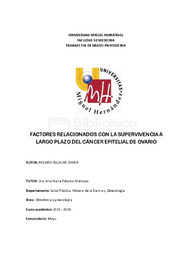Please use this identifier to cite or link to this item:
https://hdl.handle.net/11000/33753Factores relacionados con la supervivencia a largo plazo del cáncer epitelial de ovario
| Title: Factores relacionados con la supervivencia a largo plazo del cáncer epitelial de ovario |
| Authors: Roldán Aguilar, María |
| Tutor: Palacios Marqués, Ana María |
| Editor: Universidad Miguel Hernández |
| Department: Departamentos de la UMH::Salud Pública, Historia de la Ciencia y Ginecología |
| Issue Date: 2024-04-29 |
| URI: https://hdl.handle.net/11000/33753 |
| Abstract: INTRODUCCIÓN Y OBJETIVOS El cáncer de ovario ocupa la cuarta posición en incidencia de cáncer ginecológico en nuestro país, pero se trata del cáncer ginecológico más mortal. Se han identificado como factores que modifican la supervivencia del tumor: la edad, el estadiaje tumoral al diagnóstico, la variedad y grado histológicos, así como la citorreducción completa en el momento de la cirugía. El objetivo principal de este estudio es conocer la supervivencia en las mujeres diagnosticadas y tratadas de cáncer epitelial de ovario en el Hospital General Universitario Dr. Balmis, así como identificar qué factores condicionan una tasa de supervivencia mayor en nuestro medio. MATERIAL Y MÉTODOS Se ha realizado un estudio observacional de cohortes retrospectivo mediante el análisis de las pacientes diagnosticadas y tratadas de cáncer de ovario entre los años 2000 y 2017 en el Hospital General Universitario Dr. Balmis. A través de la revisión de la historia clínica digital Orion Clinic se han obtenido las siguientes variables: edad, índice de masa corporal, comorbilidades asociadas, síntoma inicial, valor del CA125 (U/mL) al diagnóstico, variedad y grado histológicos, estadiaje TNM, tratamiento recibido, tipo de cirugía y los meses de supervivencia. Para el análisis estadístico se utilizó el programa R Commander Versión 2.9-1. Se utilizó el análisis de Kaplan- Meier para analizar la relación entre la supervivencia y diferentes factores pronóstico. Se consideró un p-valor como significativo si era menor a 0,05. RESULTADOS Se incluyeron 223 mujeres, de las cuales 131 (58,74%) fueron supervivientes a largo plazo (supervivencia mayor de 5 años) y 92 (41,26%) en las que la supervivencia fue menor de 5 años. Al analizar los factores relacionados con la supervivencia, las supervivientes a largo plazo, con respecto a las que presentaron una supervivencia menor o igual a cinco años, presentaron una media de edad menor (55,58 vs 65,42 años), un valor de CA-125 (U/mL) (al diagnóstico menor (131 vs 573), una menor proporción de estadios III/IV al diagnóstico (55% vs 76,1%), menor proporción de tipo histológico seroso (59,5% vs 82,6%) y de alto grado (63,4% vs 92,4%) y mayor proporción de citorreducción óptima (72,5% vs 19,6%). CONCLUSIONES Más de la mitad de las mujeres con cáncer epitelial de ovario diagnosticadas y tratadas en el HGU Dr. Balmis presentan una supervivencia a largo plazo, mayor de 5 años. Se han identificado como supervivientes a largo plazo a aquellas mujeres que son más jóvenes, que se diagnostican en un estadio temprano (I/II), que presentan un tumor epitelial no seroso y de bajo grado y en las que se consigue una citorreducción óptima. INTRODUCTION AND OBJECTIVES Ovarian cancer is the fourth most frequently diagnosed gyneacological cancer in our country, yet it carries the highest mortality rate among them. Factors modifying tumor survival have been identified: age, tumor staging at diagnosis, histological type, and grade, as well as complete cytoreduction at the time of surgery. The main objective of this study is to understand the survival of women diagnosed and treated for epithelial ovarian cancer at Dr. Balmis University General Hospital, as well as to identify factors that determine a higher survival rate in our setting. MATERIAL AND METHODS A retrospective observational cohort study was conducted by analyzing patients diagnosed and treated for ovarian cancer between 2000 and 2017 at Dr. Balmis University General Hospital. The following variables were obtained through the review of the Orion Clinic digital medical records: age, body mass index, associated comorbidities, initial symptom, CA125 (U/mL) value at diagnosis, histological type, and grade, TNM staging, treatment received, type of surgery, and months of survival. Statistical analysis was performed using R Commander Version 2.9-1. Kaplan- Meier analysis was used to examine the relationship between survival and different prognostic factors. A p-value was considered significant if less than 0.05. RESULTS A total of 223 women were included, of whom 131 (58.74%) were long-term survivors (survival greater than 5 years) and 92 (41.26%) had survival of less than 5 years. When analyzing factors related to survival among long-term survivors compared to those with survival of five years or less, long-term survivors had a lower mean age (55.58 vs. 65.42 years), lower CA-125 (U/mL) value at diagnosis (131 vs. 573), a lower proportion of stages III/IV at diagnosis (55% vs. 76.1%), a lower proportion of serous histological type (59.5% vs. 82.6%), high grade (63.4% vs. 92.4%), and a higher proportion of optimal cytoreduction (72.5% vs. 19.6%). CONCLUSIONS More than half of women diagnosed and treated for epithelial ovarian cancer at Dr. Balmis University General Hospital have long-term survival, exceeding 5 years. Long-term survivors are identified as those who are younger, diagnosed at an early stage (I/II), have a non-serous epithelial tumor of low grade, and achieve optimal cytoreduction. |
| Keywords/Subjects: Cáncer epitelial de ovario supervivencia a largo plazo estadiaje histología grado tumoral mortalidad |
| Knowledge area: CDU: Ciencias aplicadas: Medicina |
| Type of document: info:eu-repo/semantics/bachelorThesis |
| Access rights: info:eu-repo/semantics/openAccess |
| Appears in Collections: TFG- Medicina |
.png)

